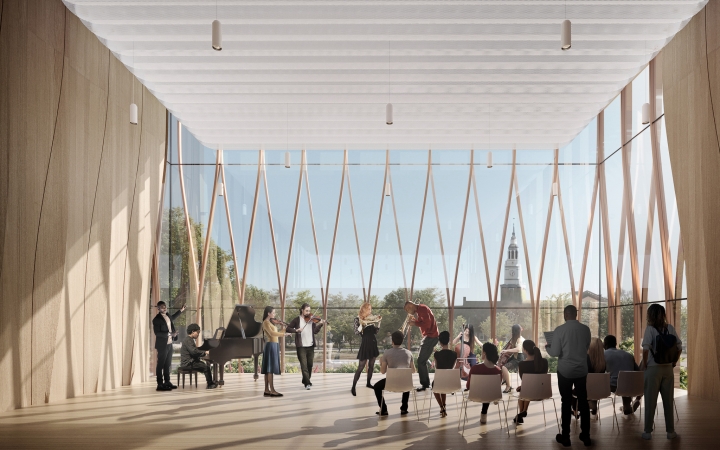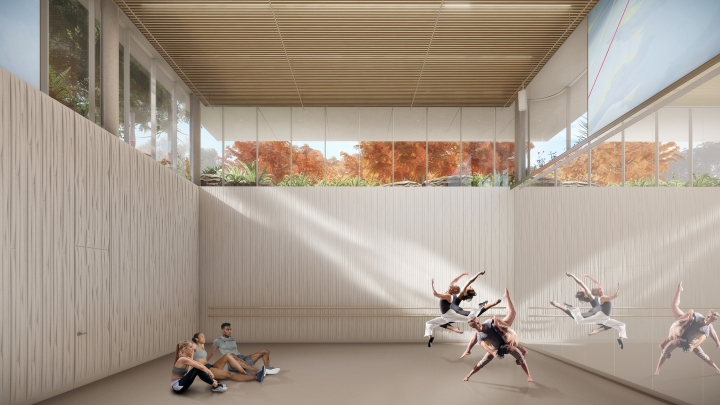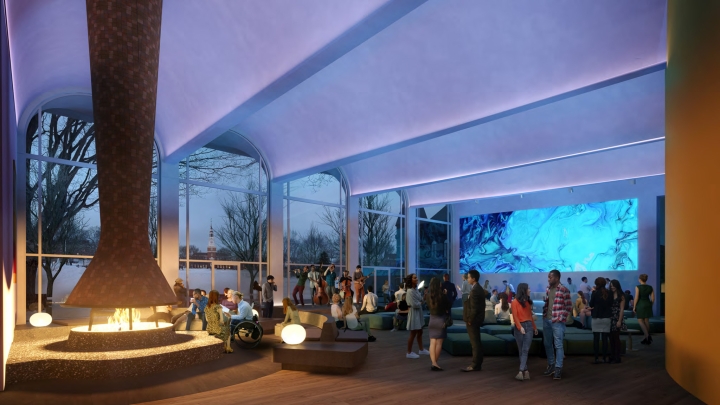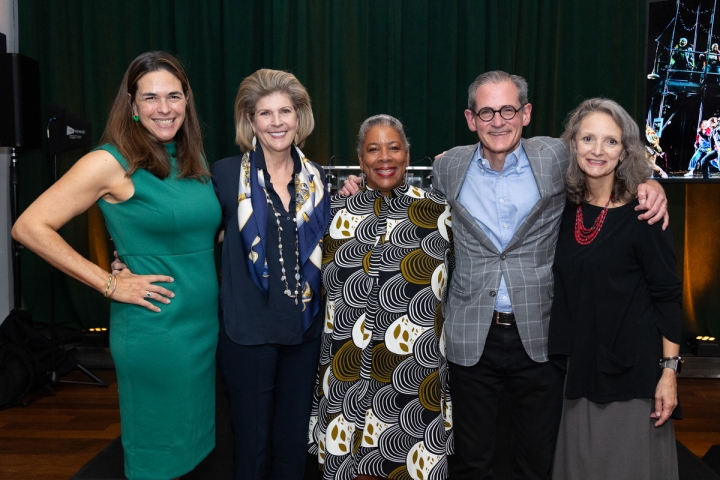Dartmouth has unveiled new details regarding three performance spaces that will support student and faculty creative work, a major focus of the Hopkins Center for the Arts’ historic transformation.
Gathering in New York City this past Thursday, Dartmouth officials announced major gifts from three alumni families to underwrite the combined 8,000 square feet of these dynamic facilities. With the announcement of these commitments, fundraising for the renovation and expansion is within $7 million of the project’s target.
“The Hop project expands our capacity to conceive, develop, and present new works and teach, perform, and gather in inspiring spaces that serve Dartmouth and the entire Upper Valley community,” says Mary Lou Aleskie, the Howard Gilman ’44 Executive Director of the Hopkins Center. “Having an acoustically superior recital hall, our first dance studio, and a renovated Top of the Hop with greater performance capacity is a game-changer for everyone.”
At the New York event, Laurel Richie ’81, Board of Trustees chair emerita and chair of the Hopkins Center Board of Advisors, announced the three landmark commitments, including a $10 million gift from Kate and Hans Morris ’80, whose generosity is supporting one of the most visible new venues at the Hopkins Center. A glass-walled music recital hall, situated between the Hop’s iconic multi-arched facade and the Hanover Inn, will provide gracious views of the Green and Baker Tower.
Dartmouth also announced gifts from Laurie and Dave Hodgson ’78, a trustee emeritus, for the university’s first dedicated dance studio, and from Anne Fleischli Blackburn ’91 and Trustee Jeff Blackburn ’91, who are enabling a significant refurbishment of the popular and beloved Top of the Hop.
“We thank the Morrises, the Hodgsons, and the Blackburns for embracing our vision for the arts at Dartmouth,” says President Sian Leah Beilock, who spoke at the New York gathering. “The Hop will soon be an even stronger magnet for creators who seek to make work in an environment that stokes the imagination: one that offers state-of-the-art facilities, talented collaborators, and a community eager to be challenged and inspired.”
Dartmouth is in the midst of the first major renovation of the Hopkins Center in its 61-year history. Community members have committed $82 million to date, and necessary demolition work began this past winter. The international design firm Snøhetta, partnering with the architectural firm of record Page, has developed the redesign, and every element of the concept reflects the Hopkins Center’s core principles of welcoming, gathering, and creating as foundational to the Hop’s strategic vision for its programming. The refurbishment will introduce approximately 15,000 square feet of entirely new space and transform 55,000 square feet of existing space.
The project is maintaining the Hopkins Center’s key historic features, including the expansive glass façade of the north entrance topped by the building’s widely recognized arches, while adding open and flexible performance and rehearsal spaces to meet artists’ current and future demands and enhancing the audience experience.
A gift recognizing multiple generations
At the Morrises’ request, the recital hall will be named in honor of Hans’ late father, John “Jack” Morris ’53, and their late son, John “Mac” Morris ’11. The Jack 1953 and Mac 2011 Morris Recital Hall will provide much-needed performance and rehearsal space when the Hop renovation and expansion is complete in 2025.

The Morris family has many points of connection to the Hop and to the arts at Dartmouth. Jack Morris returned to teach in the Great Issues course at Dartmouth in 1956–57, and his wife, Lu, served as the administrator in the Department of Music. Hans was in the marching band as a student, and his son Mac was a frequent inhabitant of the Hop’s music studios as he studied composition.
Hans Morris, an abiding proponent of the arts and former chair of the Hopkins Center Board of Advisors, is founder and managing partner of Nyca Partners, a venture capital firm focusing on financial technology. He advocated for the Hopkins Center’s renewal as board chair and has remained a leading voice and champion as the project has progressed.
“My mother worked in the music department in the late 1950s, and both my son and my daughter Lucy spent much of their time at Dartmouth involved in the arts. It is a core part of our family’s relationship to the College,” says Morris. “Kate and I think exposure to world-class art should be central to the experience of every single Dartmouth student, and the recital hall will enable the Hop to come closer to this goal of meeting student demand for flexible, state-of-the-art space. And it’s a spectacular structure, an absolutely beautiful addition to the remarkable mix of architectural styles ringing the Green.”
The stunning Jack 1953 and Mac 2011 Morris Recital Hall, featuring exceptional acoustics, is expected to be in use 12 or more hours nearly every day, as it will establish a premiere space for the teaching, presenting, and recording of performances.
The recital hall will host classes, student presentations, and guest artists who are performing for ticketed events. The hall will be able to accommodate the Dartmouth Symphony Orchestra and will provide an appropriately sized rehearsal and performance space, with seating for up to 150, for other ensembles as well, including the Coast Jazz Orchestra and the Dartmouth College Glee Club. This in turn will free up Spaulding Auditorium, where rehearsals for large-scale ensembles currently take place.
“The Morris family has a long and deep history with the arts at Dartmouth—as students, faculty, volunteer leaders, and philanthropists,” says Richie. “This magnificent new recital hall embodies a lifelong passion for the arts that spans three generations and serves as an unequivocal affirmation of the centrality of the Hop to the Dartmouth experience. Through their generosity, the Morrises have ensured that future generations of students, faculty, staff, visiting artists, and members of the Upper Valley community will experience the transformative power of the arts to bring people together and to spread joy.”
Aleskie adds, “This recital hall perfectly reflects the Morris family’s commitment to music. Every note sounded in this space will be a tribute to this family.”
A new dance studio and rejuvenated Top of the Hop
Dartmouth has been a hub of innovative choreography for several decades. The internationally renowned dance company Pilobolus was founded at Dartmouth, and the Hop for many years has had residency and commissioning relationships with leading dance companies such as the Mark Morris Dance Group and the Dance Theatre of Harlem.

Dave Hodgson, a former chair of the President’s Leadership Council, and his family—Laurie, Nora ’13, Nick ’16, and John—embraced the new dance studio, which will be located directly below the recital hall. The Hodgson Family Dance Studio will offer 24-foot ceilings, mirrored walls, a sprung floor, and a clerestory glass wall that floods the space with daylight. The venue will support dance rehearsals and growing demand for dance classes.
“Dartmouth didn’t have any dance groups when the Hop opened in 1962, and now we have nearly 20—but we’ve never had a professional dance studio in the Hopkins Center,” says Aleskie. “When the Hop reopens, we’ll have four spaces with sprung floors, and the new studio will advance what the future of dance can be.”
The Top of the Hop provides an exceptional view of the Green and offers a comfortable place for students, faculty, and staff to meet. The space is being renewed in a manner that respects and enhances its mid-20th century architecture and maintains its distinctive fireplace. The refurbishment will expand its floor space, increase seating, and, with improved lighting and acoustics, enable informal performances, such as improv comedy, cabaret, and small music ensembles. The introduction of café space will provide refreshments during events and a coffee bar for students during the day.

“Jeff and I both loved spending time studying and taking in the amazing views from the Top of the Hop. While it’s always been a great place to meet friends, study between classes, or enjoy the view, it’s evolving into even more of a gathering spot,” says Anne Fleischli Blackburn, a member of the Hopkins Center Board of Advisors.
The Hopkins Center is a gateway to Dartmouth’s Arts District, created over the past decade, which includes the recently expanded Hood Museum of Art and the Black Family Visual Arts Center. As an essential element of the Dartmouth liberal arts experience, the arts nurture curiosity, creativity, and empathy. All three gifts announced in New York advance the Hopkins Center’s mission and enhance opportunities for artistic exploration and growth; inspiring students, faculty, staff, and alumni; and welcoming visitors from across New England and beyond.
